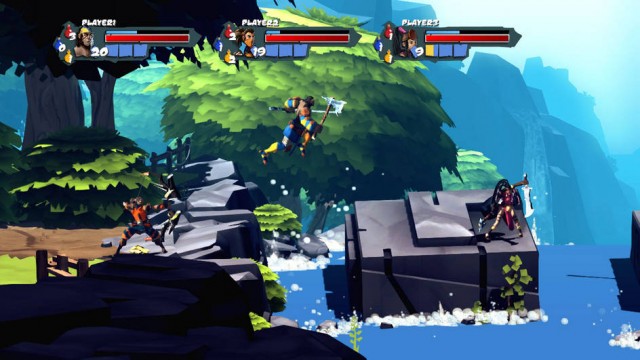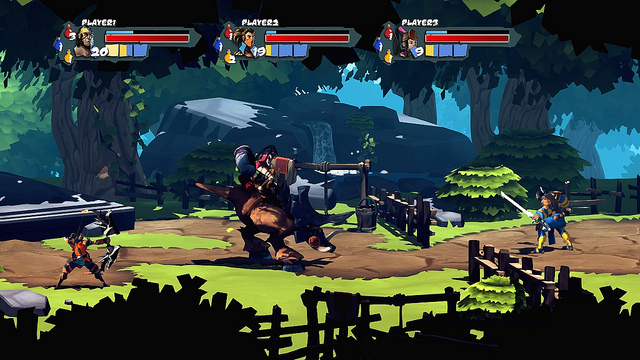Sacred Citadel Review
The word “average” has developed a really bad reputation over the last few years – certainly more so since the advent of the internet, which gave everyone with a working connection and opposable thumbs a soapbox to stand on and the supposed right to call themselves “critics”. In the video games industry at least, “average” is positively damning. It’s actually more desirable to have your game reviewed and rated as “poor”, because then you might just achieve cult status, or appeal to that sub-sect of gamers who seek out anything deemed “so bad that it’s good”. If your game is average, that will never happen. Average is beige, average is bland, average doesn’t taste bad or good; it’s tasteless. It has nothing to really offer anyone, while it doesn’t really do anything to put you off. And yet, “average” is actually a much, much better outcome than “poor”. On a 1-10 scale, five is a hell of a lot higher than one. In fact, “average” is the absolute minimum a game should be allowed to score before anyone deems it an actual failure. In fact, average is good simply because, by definition, it isn’t bad (yes, it could work the other way if you like, but that’s a bit too ‘glass-half-empty’ for us here at GodisaGeek).
Since my somewhat rambling opener has probably already given the score away like Marty McFly’s almanac, there’s no point in you skipping to the bottom, and so you may as well read on and find out exactly why Sacred Citadel so firmly occupies its middle-ground position and why it’s really not a bad thing at all. Honest.

Southend Interactive’s side-scrolling, RPG-lite hack ‘n’ slash is set in the universe of Deep Silver’s Sacred franchise, a high fantasy series that takes Diablo’s rogue-like loot and XP obsession and transplants it into the slightly more whimsical (though no less dangerous) world of Ancaria. It’s never set the Earth ablaze, despite a solid following among the PC community, but the Sacred franchise is not without merit. It’s world is inventive, for one thing, and the history is as deep as you’ll find anywhere else. Sacred 2: Fallen Angel was released on PC in 2008 and on consoles around six months later and has since earned itself a respectable Metacritic score of 71, which should give some indication as to the franchise’s level of popularity. Even so, the excitement surrounding spin-off Sacred Citadel took many people by surprise, but was perhaps understandable given the direction Southend Interactive have take and the recent resurgence of the 2D action game.
Sacred Citadel most resembles classic arcade title Golden Axe in terms of its aesthetics and animations; while the graphics are, quite obviously, far superior, the movement of the characters, the mounts they can use and the world itself evokes hazy memories from my childhood that have brought an occasional smile to my lips while playing. The story is certainly no more complicated: A great evil threatens the world of Ancaria with an invasion that begins by sending out small raiding parties of inept, brutish grunts and doesn’t bother hurling its most powerful resources at the world until a bevy of hardy mercenaries beat their way to its door. There’s an artefact or two that must be found and destroyed before the great evil gets a hold of them, and despite each hero’s obvious experience and skill, they’ll begin the adventure as useless lumps that can only attack in one of two ways before growing gradually more talented by repeatedly hitting the aforementioned brutish grunts in the head. I’m not being facetious, but that’s almost entirely what Sacred Citadel’s narrative entails – although, you’d be forgiven for thinking that I mean that as a bad thing.
In fact, Sacred Citadel’s narrative is exactly what it needs to be; a reason for four mercenaries of various skills and outfit colours to hack, slash, cast and roll their way through four or five hours of increasingly difficult enemies. In order to add some life to proceedings, there are various other ingredients stirred in. For example, the RPG sprinklings that flavour Sacred Citadel’s broth are light, neither souring the taste nor igniting the buds. Killing enemies grants XP and loot and both make you stronger, the former by unlocking melee combos and increasing your stats and the latter by, well, increasing your stats. Unfortunately, while it does prick your palette a little, it’s all very, very shallow. Regardless of which character you choose from the classic Action RPG line-up of Fighter (Safiri Warrior), Ranger (Ancarian Ranger), Mage (Seraphim Mage) and Cleric (Khukri Shaman) you’ll be dual-wielding weapons with Square (on the PlayStation 3 version, at least), activating a heavy attack with Triangle and using a special attack with Circle. The combos differ in animation only, all armour and primary weapons can be used by any character and each of the four protagonists is locked so rigidly within an RPG archetype (the Shaman alone can heal her allies, for instance) that there’s no need for skill trees or unlockable abilities of any kind.

In each stage of each Act, your goal is to walk from the left side of the screen to the right side of the screen, kill everything that moves, and then repeat until the boss fight (some of which are screen-filling monstrosities that genuinely elevate the co-op way beyond the standards of the rest of the game). Along the way, you’ll level up (but can’t spend your points on Attack, Defence, Dexterity and Power until after the stage) and find gear (which you can’t equip until after the fight), and collect potions and crystal shards. Potions come in three varieties; health, power and rage. Health and power refill your life and magic bars, respectively, while rage potions give you a temporary boost to your Attack value. The shards offer more long-term buffs such as increased dexterity or defence that last for a set amount of game time before expiring. It’s not hugely original (it’s not original at all, actually) but it does add another thin layer to the gameplay.
Tackled alone, Sacred Citadel becomes something of a behemoth at times. Potions are few and far between, and random drops of life-replenishing foodstuffs are rare – especially during boss fights when you really need them. However, jump into the game either online or with a few friends and it becomes a whole different story. The promises of group tactics in the pre-releases run-up were mostly utter tosh, but you can mix up skills by, say, launching an enemy into the air for an ally to juggle. The Ancarian Ranger has a nifty ranged attack (duh) to keep enemies at bay should they sneak past the tanking Safiri Warrior, and the Kukhri Shaman can heal everyone – although her special skill has a significant cooldown period. You can’t take two of the same character into a game, and so Sacred Citadel promotes its own flimsy group dynamic in a way that works in its favour. As a co-op experience, there is fun to be had, but if you’re playing alone, Sacred Citadel is going to get very boring very fast, as it really doesn’t get any more exciting than hitting the face buttons until everything is dead, again and again. The mounts are a decent enough addition, allowing you to sit astride a towering beast or hijack a Grimmoc tank and crush everything in your way. These sections are spread quite widely, however, and so the fleeting joy they provide is nowhere near frequent enough.
The short levels present a decent mix of locales from daylight forests to deep, dark mines and eerie dungeons, and the art style is something to applaud. The cartoonish main characters are bright and garish, and the whole game takes a minimalist approach to animation. Small touches in each level add to the atmosphere (such as workers toiling away in the background of the mines), and environmental hazards increase the danger of some stages and keep you on your toes. An early example is an inexplicable swinging tree trunk that you can bat back and forth on one particular screen to knock enemies flying. It’s not only tricky to coordinate the fight, it’s also mildly hilarious to keep batting enemies up into the air when they approach. It can sometimes be hard to spot your character during the busier fights, although nine times out of ten simply spamming attack, roll, attack will see you through. That being said, the hand-painted style of the backgrounds is often quite striking, and lends the game a kind of Saturday-morning-cartoon appeal that will be enough to win over many gamers.

Overall, the audio does a solid enough job but isn’t going to win any awards. Allies and monsters grunt and snarl at the right moments, the score dips and raises between quiet, incidental menu music and thumping battle melodies that are intended to stir the blood but really just remind you that you’re playing a game and it’s time to fight. Again.
VERDICT: Sacred Citadel is a very average game, if that makes any sense. It’s so average that it can’t be called a bad game, but can’t be praised much either. The graphics manage to be pretty and bland at the same time, while the low number of colours can make your character hard to locate in a fair-sized scrum. The RPG elements add something to what you’re doing, but they’re so generic and so casually inserted that they feel like an aside, rather than an important element that the gameplay would suffer without. A lack of distinct styles seriously hamstrings the character roster, although each character’s “special attack” is useful enough to turn the tide of at least the lower-level grunt fights. On the whole, Sacred Citadel is a game that does precisely what it set out to do without acquiescing to a single moment of extra work. The result is a game that works quite well as a multiplayer time-killer but poorly as a serious soloist’s challenge, a game that looks alright without looking spectacular and that provides evenly-spaced, short-lived thrills within an otherwise fairly straightforward framework. It’s certainly not a bad game; it’s just not really that good, either.

AVERAGE. The epitome of a 50/50 game, this title will be unspectacular but inoffensive, charmless but amiable. We aren’t condemning a game by scoring it a 5, but we certainly aren’t championing it, either.




